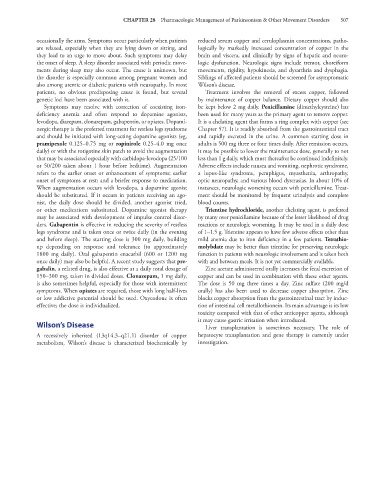Page 521 - Basic _ Clinical Pharmacology ( PDFDrive )
P. 521
CHAPTER 28 Pharmacologic Management of Parkinsonism & Other Movement Disorders 507
occasionally the arms. Symptoms occur particularly when patients reduced serum copper and ceruloplasmin concentrations, patho-
are relaxed, especially when they are lying down or sitting, and logically by markedly increased concentration of copper in the
they lead to an urge to move about. Such symptoms may delay brain and viscera, and clinically by signs of hepatic and neuro-
the onset of sleep. A sleep disorder associated with periodic move- logic dysfunction. Neurologic signs include tremor, choreiform
ments during sleep may also occur. The cause is unknown, but movements, rigidity, hypokinesia, and dysarthria and dysphagia.
the disorder is especially common among pregnant women and Siblings of affected patients should be screened for asymptomatic
also among uremic or diabetic patients with neuropathy. In most Wilson’s disease.
patients, no obvious predisposing cause is found, but several Treatment involves the removal of excess copper, followed
genetic loci have been associated with it. by maintenance of copper balance. Dietary copper should also
Symptoms may resolve with correction of coexisting iron- be kept below 2 mg daily. Penicillamine (dimethylcysteine) has
deficiency anemia and often respond to dopamine agonists, been used for many years as the primary agent to remove copper.
levodopa, diazepam, clonazepam, gabapentin, or opiates. Dopami- It is a chelating agent that forms a ring complex with copper (see
nergic therapy is the preferred treatment for restless legs syndrome Chapter 57). It is readily absorbed from the gastrointestinal tract
and should be initiated with long-acting dopamine agonists (eg, and rapidly excreted in the urine. A common starting dose in
pramipexole 0.125–0.75 mg or ropinirole 0.25–4.0 mg once adults is 500 mg three or four times daily. After remission occurs,
daily) or with the rotigotine skin patch to avoid the augmentation it may be possible to lower the maintenance dose, generally to not
that may be associated especially with carbidopa-levodopa (25/100 less than 1 g daily, which must thereafter be continued indefinitely.
or 50/200 taken about 1 hour before bedtime). Augmentation Adverse effects include nausea and vomiting, nephrotic syndrome,
refers to the earlier onset or enhancement of symptoms; earlier a lupus-like syndrome, pemphigus, myasthenia, arthropathy,
onset of symptoms at rest; and a briefer response to medication. optic neuropathy, and various blood dyscrasias. In about 10% of
When augmentation occurs with levodopa, a dopamine agonist instances, neurologic worsening occurs with penicillamine. Treat-
should be substituted. If it occurs in patients receiving an ago- ment should be monitored by frequent urinalysis and complete
nist, the daily dose should be divided, another agonist tried, blood counts.
or other medications substituted. Dopamine agonist therapy Trientine hydrochloride, another chelating agent, is preferred
may be associated with development of impulse control disor- by many over penicillamine because of the lesser likelihood of drug
ders. Gabapentin is effective in reducing the severity of restless reactions or neurologic worsening. It may be used in a daily dose
legs syndrome and is taken once or twice daily (in the evening of 1–1.5 g. Trientine appears to have few adverse effects other than
and before sleep). The starting dose is 300 mg daily, building mild anemia due to iron deficiency in a few patients. Tetrathio-
up depending on response and tolerance (to approximately molybdate may be better than trientine for preserving neurologic
1800 mg daily). Oral gabapentin enacarbil (600 or 1200 mg function in patients with neurologic involvement and is taken both
once daily) may also be helpful. A recent study suggests that pre- with and between meals. It is not yet commercially available.
gabalin, a related drug, is also effective at a daily total dosage of Zinc acetate administered orally increases the fecal excretion of
150–300 mg, taken in divided doses. Clonazepam, 1 mg daily, copper and can be used in combination with these other agents.
is also sometimes helpful, especially for those with intermittent The dose is 50 mg three times a day. Zinc sulfate (200 mg/d
symptoms. When opiates are required, those with long half-lives orally) has also been used to decrease copper absorption. Zinc
or low addictive potential should be used. Oxycodone is often blocks copper absorption from the gastrointestinal tract by induc-
effective; the dose is individualized. tion of intestinal cell metallothionein. Its main advantage is its low
toxicity compared with that of other anticopper agents, although
it may cause gastric irritation when introduced.
Wilson’s Disease Liver transplantation is sometimes necessary. The role of
A recessively inherited (13q14.3–q21.1) disorder of copper hepatocyte transplantation and gene therapy is currently under
metabolism, Wilson’s disease is characterized biochemically by investigation.

